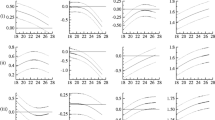Abstract
This paper investigates the relationships between the employment and the crime decisions of youths. We assume that youths maximize expected utility and we allow divergence betweenex ante andex post time allocations to legal and illegal activities. This gap motivates the exclusion restrictions which allow us to explore feedbacks between criminality and employability. Moreover, by using a panel of individual-level data, we are able to investigate the impact of historical crime and labor-market activities on the current delinquency and employability of juveniles. The measures of the endogeneous variables of our model are dichotomous. Furthermore, our sample is choice-based. Maximum-likelihood procedures which deal with these complications are used in our empirical investigations.
Similar content being viewed by others
References
Amemiya, T. (1978). The estimation of simultaneous equation generalized probit model.Econometrica 46: 193–205.
Avery, R. B., Hansen, L. P., Hotz, J. V. (1983). Multiperiod probit models and orthogonality condition estimation.Int. Econ. Rev. 24: 21–36.
Becker, G. (1957).The Economics of Discrimination, University of Chicago Press, Chicago.
Becker, G. (1964). Crime and punishment: An economic approach.J. Polit. Econ. 76: 169–217.
Berk, R. A., Lenihan, K. J., and Rossi, P. H. (1980). Crime and poverty: Some experimental evidence from ex-offenders.Am. Sociol. Rev. 45: 766–786.
Block, M. and Heineke, J. M. (1975). A labor theoretic analysis of the criminal choice.Am. Econ. Rev. 65: 314–325.
Block, M. and Heineke, J. M. (1973). The allocation of effort under uncertainty: The case of risk adverse behavior.J. Polit. Econ. 81: 376–385.
Block, M. K., and Lind, R. C. (1975a). Crime and punishment reconsidered.J. Leg. Stud. 4: 241–247.
Block, M. K., and Lind, R. C. (1975b). An economic analysis of crimes punishable by imprisonment.J. Leg. Stud. 4: 479–492.
Butler, J. S., and Moffitt, R. (1982). A computationally efficient quadrature procedure for the one-factor multinomial probit model.Econometrica 50: 761–765.
Cloward, R. and Ohlin, L. (1960).Delinquency and Opportunity, Free Press. Glencoe, III.
Ehrlich, I. (1973). Participation in illegitimate activities: A theoretical and empirical investigation.J. Polit. Econ. 81: 521–565.
Elliot, D., and Voss, H. (1974).Delinquency and Dropout, Lexington Books, Lexington, Mass.
Fleisher, B. (1963). The effects of unemployment on delinquent behavior.J Polit. Econ. 71: 543–555.
Fleisher, B. (1966). The effect of income on delinquency.Am. Econ. Rev. 56: 118–137.
Freeman, R. B. (1983). Crime and unemployment. In Wilson, J. Q. (ed.),Crime and Public Policy, Institute for Contemporary Studies, San Francisco, pp. 89–106.
Glaser, D. and Rice, K. (1959). Crime, age, and unemployment.Am. Sociol. Rev. 24: 679–686.
Harrison, B. (1972).Education, Training and the Urban Ghetto, Johns Hopkins University Press, Baltimore.
Heckman, J. J. (1978a). Dummy endogenous variables in a simultaneous equation system.Econometrica 46: 931–959.
Heckman, J. J. (1978b). Simple statistical models for discrete panel data developed and applied to test the hypothesis of true state dependence against the hypothesis of spurious state dependence.Ann. INS 30J31: 227–269.
Heckman, J. J. (1981). Statistical models for discrete panel data. In Manski, C., and McFadden, D. (eds.),Structural Analysis of Discrete Data with Econometric Applications, MIT Press, Cambridge, Mass.
Hindelang, M. J., Hirschi, T., and Weis, J. G. (1979). Correlates of delinquency: The illusion of discrepancy between self report and official measures.Am. Sociol. Rev. 44: 995–1014.
Hirschi, T. (1969).Causes of Delinquency, University of California. Press, Berkeley.
Holtzman, H. (1983). The serious habitual property offender as “moonlighter”: An empircial study of labor force participation among robbers and burglars.J. Crim. Law Criminol. 73: 1774–1792.
Keifer, N. (1982). Testing for dependence in multivariate probit models.Biometrika 69: 161–166.
Leiberg, L. (ed.) (1978).Crime and Employment Issues, American University, Washington, D.C.
Leonard, J. W. (1967). Dismissal for off-the-job criminal behavior.Month. Labor Rev. 90: 21–26.
Long, S. K., and Witte, A. (1981) Current economic trends: Implications for crime and criminal justice. In Wright, K. N. (ed.),Crime and Criminal Justice in a Declining Economy, Gunn and Hain, Oelgeschlager.
Manski, C. F., and Lerman, S. R. (1977). The estimation of choice probabilities from choice based samples.Econometrica 45: 1977–1988.
Mantel, N. (1973). Synthetic retrospective studies and related topics.Biometrics 29: 479–486.
Myers, S. 1983a. Racial differences in post-prison employment.Soc. Sci. Q. 64: 655–69.
Myers, S. 1983b. Estimating the economic model of crime: Employment versus punishment effects.Q. J. Econ. 98: 157–166.
Phillips, L., Votey, H., and Maxwell, D. (1972). Crime, youth and the labor market.J. Polit. Econ. 80: 491–504.
Pirog-Good, M. (1981).Relationships Between Youth Crime and Employment: A Theoretical and Empirical Approach. Ph.D. dissertation, University of Pennsylvania, Philadelphia.
Portnoy, B. M. (1970). Employment of former criminals.Cornell Law Rev. 55: 306–320.
Rossi, P., Berk, R., and Lenihan, K. (1980).Money, Work and Crime: Experimental Evidence, Academic Press, New York.
Schmidt, P., and Witte, A. (1984).An Economic Analysis of Crime and Justice, Academic Press, New York.
Sickles, R. C, and Taubman, P. (1986). An analysis of health and the retirement status of the elderly.Econometrica (in press).
Sickles, R. C., Schmidt, P., and Witte, A. (1979). An analysis of time sentenced after release from prison: An application of simultaneous tobit.J. Econ. Bus. 31: 166–171.
Singell, L. D. (1967). An examination of the empirical relationship between unemployment and juvenile delinquency.Am. J. Econ. Social. 26: 377–386.
Sjoquist, D. L. (1973). Property crime and economic behavior: Some empirical evidence.Am. Econ. Rev. 63: 439–446.
Spence, M. (1973). Job market signalling.Q. J. Econ. 87: 355–374.
Stiglitz, J. E. (1973). The theory of screening, education and the distribution of income. Cowles Foundation Discussion Paper No. 354.
Sullivan, M. L. (1983). Youth crime: New York's varieties.New York Affairs, NYU Urban Research Center (4 Washington Square North, New York, N.Y. 10003).
Thornberry, T. P., and Christenson, R. L. (1984). Unemployment and criminal involvement: An investigation of reciprocal causal structures.Am. Sociol. Rev. 49: 398–411.
Witte, A. (1980). Estimating the economic model of crime with individual level data.Q. J. Econ. 94: 57–84.
Witte, A. (1983). Estimating the economic model of crime: Reply.Q. J. Econ. 98: 167–175.
Author information
Authors and Affiliations
Rights and permissions
About this article
Cite this article
Good, D.H., Pirog-Good, M.A. & Sickles, R.C. An analysis of youth crime and employment patterns. J Quant Criminol 2, 219–236 (1986). https://doi.org/10.1007/BF01066527
Issue Date:
DOI: https://doi.org/10.1007/BF01066527




